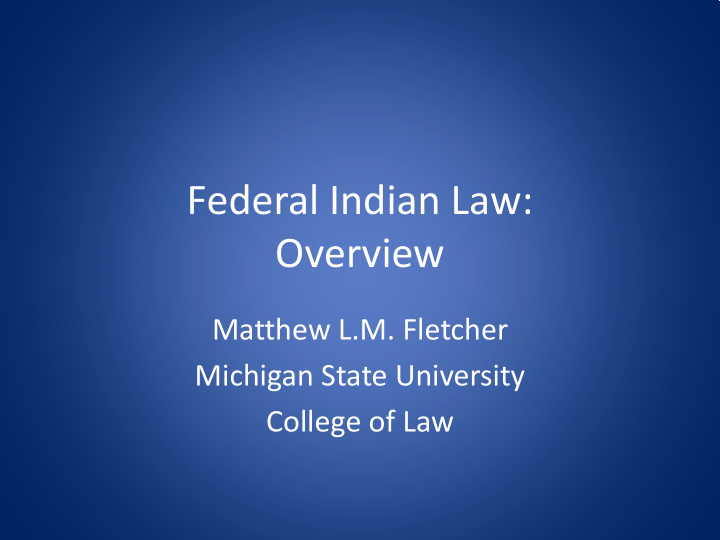



Federal Indian Law: Overview Matthew L.M. Fletcher Michigan State University College of Law
Indian country
Indian Lands: 56 Million Acres in Tribal Control
Three Foundational Principles 1. Plenary Federal Power 2. States Excluded 3. Inherent Tribal Sovereignty
Sources of Indian Law 1. Indian Commerce Clause 2. Indian Treaties 3. Federal Common Law
Eras of Federal Indian Law (and Related Legal Doctrines)
Treaty Era
United States v. Winans • The right to resort to the fishing places in controversy was a part of larger rights possessed by the Indians … and which were not much less necessary to the existence of the Indians than the atmosphere they breathed. 198 U.S. 371, 381 (1905) •
Washington v. Fishing Vessel Assn. [I]t is the intention of the parties, and not solely that of the superior side, that must control any attempt to interpret [Indian] treaties. ... [T]he United States, as the party with the presumptively superior negotiating skills and superior knowledge of the language in which the treaty is recorded, has a responsibility to avoid taking advantage of the other side. "[T]he treaty must therefore be construed, not according to the technical meaning of its words to learned lawyers, but in the sense in which they would naturally be understood by the Indians.“ 443 U.S. 658, 675-76 (1979)
Indian Treaty Rights
Removal and Reservation Era
The Cherokee Cases
Worcester v. Georgia The Cherokee Nation … is a distinct community occupying its own territory … in which the laws of Georgia can have no force, and which the citizens of Georgia have no right to enter but with the assent of the Cherokees themselves, or in conformity with treaties and with the acts of Congress. 31 U.S. 515, 561 (1832)
Assimilation and Allotment Era
Indian Country Establishment and Disestablishment
Checkerboarded Reservations
Reorganization Era
The Federal Trust Responsibility to Indian Nations
Seminole Tribe v. United States Congress … has charged itself with moral obligations of the highest responsibility and trust. Its conduct … should therefore be judged by the most exacting fiduciary standards. 316 U.S. 286, 296-97 (1942)
Termination Era
Menominee Tribe v. United States
Tribal Self-Determination Era
Inherent Tribal Authority
Williams v. Lee [State law is preempted if it interferes with] the right of reservation Indians to make their own laws and be ruled by them. 359 U.S. 217, 220 (1959)
Santa Clara Pueblo v. Martinez Although no longer "possessed of the full attributes of sovereignty," [Indian tribes] remain a "separate people, with the power of regulating their internal and social relations." … They have power to make their own substantive law in internal matters, [including] … membership …; inheritance rules …; …domestic relations…, and to enforce that law in their own forums…. 436 U.S. 49, 55-56 (1978)
Self-Determination Acts
Indian Gaming
Key Topics in Indian Law
Tribal Authority over Nonmembers
Tribal Economies
Recommend
More recommend